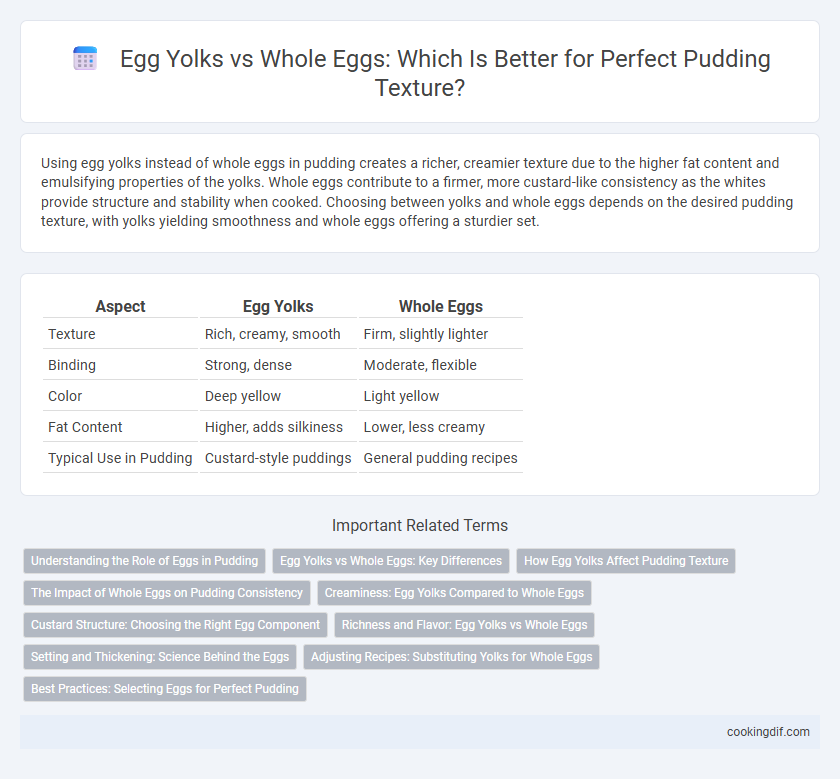Using egg yolks instead of whole eggs in pudding creates a richer, creamier texture due to the higher fat content and emulsifying properties of the yolks. Whole eggs contribute to a firmer, more custard-like consistency as the whites provide structure and stability when cooked. Choosing between yolks and whole eggs depends on the desired pudding texture, with yolks yielding smoothness and whole eggs offering a sturdier set.
Table of Comparison
| Aspect | Egg Yolks | Whole Eggs |
|---|---|---|
| Texture | Rich, creamy, smooth | Firm, slightly lighter |
| Binding | Strong, dense | Moderate, flexible |
| Color | Deep yellow | Light yellow |
| Fat Content | Higher, adds silkiness | Lower, less creamy |
| Typical Use in Pudding | Custard-style puddings | General pudding recipes |
Understanding the Role of Eggs in Pudding
Egg yolks contribute to a rich, creamy pudding texture by emulsifying fats and providing a smooth, velvety consistency, while whole eggs add structure and firmness due to their higher protein content. Using only yolks results in a softer, silkier pudding, whereas whole eggs create a denser, more custard-like final product. The balance between yolks and whites affects the pudding's stability, mouthfeel, and overall creaminess, making egg selection crucial in recipe formulation.
Egg Yolks vs Whole Eggs: Key Differences
Egg yolks create a richer, creamier pudding texture due to their higher fat content and natural emulsifiers, resulting in a smooth, velvety consistency. Whole eggs contribute to a firmer, more set pudding with a slightly lighter texture because the egg whites provide additional structure and protein. Choosing egg yolks enhances custard-like richness, while whole eggs offer a balanced firmness ideal for traditional pudding recipes.
How Egg Yolks Affect Pudding Texture
Egg yolks contribute a rich, creamy texture to pudding by providing emulsifiers and fat that enhance smoothness and mouthfeel. The lecithin in yolks stabilizes the mixture, resulting in a thicker, silkier consistency compared to using whole eggs. Whole eggs create a firmer, less velvety pudding due to the additional egg whites, which can cause a more rubbery texture.
The Impact of Whole Eggs on Pudding Consistency
Whole eggs contribute to a smoother, creamier pudding texture by balancing the richness of egg yolks with the lightness of egg whites. The proteins in whole eggs coagulate during cooking, providing structure and stability without making the pudding overly dense. Using whole eggs results in a well-rounded consistency, combining firmness with a delicate, silky mouthfeel.
Creaminess: Egg Yolks Compared to Whole Eggs
Egg yolks contribute significantly more creaminess to pudding than whole eggs due to their higher fat content and emulsifying properties. The rich lipids in egg yolks create a smoother, silkier texture by binding fats and water molecules, enhancing the mouthfeel. Whole eggs, containing both yolks and whites, result in a firmer pudding with less creaminess because egg whites provide structure but lack fat.
Custard Structure: Choosing the Right Egg Component
Egg yolks provide a richer, creamier custard texture in pudding due to their high fat content and emulsifying properties, which help achieve a smooth and velvety consistency. Whole eggs contribute to a firmer and more stable structure by adding both protein and moisture, but may result in a less silky mouthfeel compared to yolk-only recipes. Balancing yolks and whole eggs allows precise control over pudding firmness and creaminess, optimizing custard texture based on desired outcome.
Richness and Flavor: Egg Yolks vs Whole Eggs
Egg yolks contribute a richer, creamier texture and enhance the flavor depth of pudding due to their higher fat content and emulsifying properties. Whole eggs provide structure and firmness but can result in a lighter, less velvety consistency compared to yolks alone. Using egg yolks emphasizes a smooth, luxurious mouthfeel and intense taste, making them preferable for decadent pudding recipes.
Setting and Thickening: Science Behind the Eggs
Egg yolks contain a higher concentration of proteins and fats that excel in coagulating and thickening, resulting in a rich, creamy pudding texture with a firm yet smooth set. Whole eggs include both yolks and whites; the whites add additional proteins that contribute to a slightly firmer and more custard-like structure but may lead to a less creamy consistency. The balance between yolk and white proteins influences the pudding's setting temperature and texture by controlling the degree of gelation and stability during cooking.
Adjusting Recipes: Substituting Yolks for Whole Eggs
Adjusting pudding recipes by substituting egg yolks for whole eggs results in a richer, creamier texture due to the higher fat content and emulsifying properties of yolks. Using only yolks intensifies the custard-like consistency while reducing the firmness that whole eggs provide from their whites. For a smoother pudding, replacing whole eggs with three yolks per two whole eggs usually maintains balance between richness and structure without compromising setting time.
Best Practices: Selecting Eggs for Perfect Pudding
Using egg yolks in pudding recipes results in a richer, creamier texture due to their higher fat content and emulsifying properties, which help create a smooth, velvety consistency. Whole eggs contribute to a firmer, more custard-like texture because of the combination of whites and yolks, but can sometimes lead to a less silky finish. For perfect pudding texture, select fresh, high-quality eggs and adjust the yolk-to-white ratio depending on the desired creaminess and firmness.
Egg yolks vs whole eggs for pudding texture Infographic

 cookingdif.com
cookingdif.com